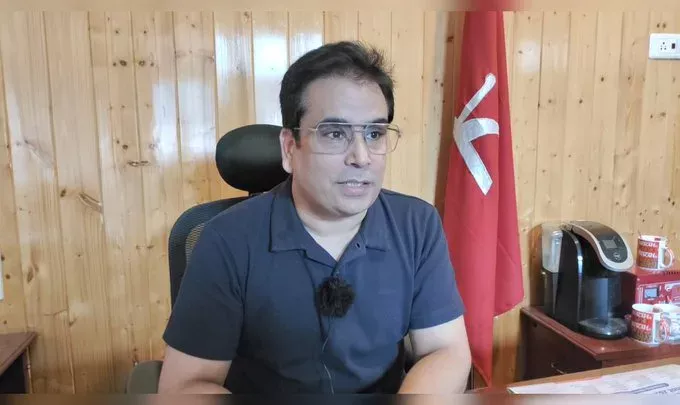Public Money, Shrine Donations, and the Politics of Merit in Jammu & Kashmir
By: Javid Amin | 25 November 2025
A Controversy at the Crossroads of Religion, Education, and Governance
The debate around the Shri Mata Vaishno Devi Institute of Medical Excellence (SMVDIME) has grown into one of the most politically charged education-related controversies in Jammu & Kashmir in recent years. What began as a dispute about MBBS admissions quickly evolved into a larger conversation about public funding, shrine donations, constitutional guarantees, and religious identity.
At the center of this controversy is National Conference (NC) leader Tanvir Sadiq’s claim that SMVDIME is not funded solely by pilgrim donations, but also by substantial government grants—₹24 crore in 2024 and ₹28 crore in 2025. This assertion, if accurate, reshapes the entire debate: from an argument about shrine-funded entitlement to a constitutional question of equal access to publicly funded institutions.
The issue sits at the intersection of multiple fault lines:
-
religion-based entitlement claims
-
minority representation fears
-
regional tensions between Jammu and Kashmir
-
the politicization of higher education
-
the role of shrine boards as public bodies
-
constitutional mandates on equality and merit
This long-form analysis explores the controversy in depth, tracing the political, legal, financial, and social implications of Sadiq’s claims.
Background: The Admission Controversy That Sparked the Debate
The SMVDIME admission row began when it was revealed that nearly 90% of the inaugural MBBS batch consisted of Muslim students from Kashmir. This demographic profile triggered objections from:
-
certain Jammu-based groups
-
affiliates of Sangh-aligned Hindu organizations
-
commentators emphasizing shrine donations
The argument raised was:
“If the institution is funded by Vaishno Devi shrine donations given by Hindu pilgrims, Hindu students should have preference.”
This claim led to demands for:
-
Hindu-only or Hindu-majority admissions
-
regional quotas
-
religiously-defined benefits based on pilgrimage contributions
As the controversy deepened, political parties stepped in, each framing the issue according to their ideological narratives.
It was in this context that Tanvir Sadiq publicly contested the very foundation of these claims: whether SMVDIME is indeed purely shrine-funded.
Tanvir Sadiq’s Claim: Government Money Is Involved, Therefore Equal Rights Apply
NC leader Tanvir Sadiq asserted that:
-
SMVDIME and its parent university receive large annual government grants.
-
₹24 crore was allocated in 2024 as grant-in-aid from J&K’s budget.
-
₹28 crore was allocated in 2025.
Thus, the institution is not solely funded by pilgrim donations.
1. The Core Argument
If public money is used—even partially—then:
-
the institution becomes accountable to all citizens, not one religious community.
-
admissions must follow constitutional norms of equality, merit, and non-discrimination.
-
no religious group can claim ownership based on donations.
-
shrine donations do not override public funding obligations.
2. Why This Claim Matters
India’s legal framework is unambiguous:
-
any educational institution receiving government funding must follow constitutional mandates.
-
discrimination based on religion is impermissible.
-
even minority institutions cannot restrict admissions based solely on donations or community identity.
Thus, Sadiq’s disclosure reframes the controversy from:
“Who should shrine donations benefit?”
to
“How should public funds be used?”
Shrine Boards as Public Institutions: A Constitutional and Legal Overview
The Shri Mata Vaishno Devi Shrine Board (SMVDSB) is not a private religious trust. It is a statutory body, created under law, and functions as a public institution. This has several implications:
1. Public Accountability
Being a statutory board, SMVDSB is:
-
answerable to state authorities
-
subject to audits
-
bound by transparency requirements
-
obligated to follow constitutional principles
This places limits on how it can allocate funds and operate institutions under its control.
2. Educational Institutions Cannot Discriminate
Even if 100% funded by shrine donations, SMVDIME cannot lawfully:
-
restrict admissions to one religion
-
give preference based solely on religious identity
-
argue that “donor faith” is a basis for admission
The Supreme Court has repeatedly affirmed:
Admissions cannot be tied to the religious identity of donors.
Thus, the demand for Hindu-only admissions has no constitutional basis.
Government Grants: What They Mean for Accountability
If SMVDIME indeed receives government grants—as Sadiq claims—then the legal obligations become even stronger:
1. Public Funds = Public Rights
Once taxpayer money flows into an institution:
-
every citizen acquires equal rights of access
-
the institution becomes part of the public education ecosystem
-
constitutional norms apply even more strongly
-
the government must ensure merit-based, non-discriminatory admissions
2. Transparency Requirements Increase
Institutions receiving government grants must:
-
publish audited financial statements
-
disclose grant utilization
-
follow public procurement norms
-
maintain reservation policies as applicable
-
adhere to national medical education guidelines
Thus, public funding increases—not reduces—public accountability.
Omar Abdullah’s Position: Merit, Constitution, and J&K’s Diversity
Chief Minister Omar Abdullah responded firmly to the controversy:
-
Admissions must be merit-based.
-
The college cannot restrict entry by religion.
-
J&K’s diversity means no institution can legally operate on religious exclusivity.
His stance aligns with:
-
Supreme Court precedent
-
Medical Council of India / NMC guidelines
-
Constitutional equality norms
-
National policy on public medical institutions
Omar framed the issue as one of governance, not religious favoritism.
BJP’s Narrative: Shrine Donations and Religious Entitlement Claims
Sections of the BJP and associated groups argue:
-
Vaishno Devi temple donations must benefit Hindu students.
-
A Hindu-run shrine should not disproportionately educate Muslim students.
-
Government grants do not negate the shrine board’s primary religious character.
This narrative frames the institution as:
-
a product of Hindu religious contribution
-
a space where religious stewardship should influence policy
-
a symbol of cultural identity
The NC counters:
-
it is a public institution
-
funded partly through taxpayer money
-
governed by constitutional obligations
The Merit vs Identity Debate
The admissions controversy highlights a persistent Indian dilemma:
Should public institutions prioritize merit or religious identity?
In the case of SMVDIME:
-
medical admissions are strictly NEET-based
-
the process is centralized and computer-allocated
-
no institution can choose students based on faith
-
demographic outcomes are incidental, not engineered
NEET ranks determined the batch profile, not institutional policy.
Regional Dynamics: Jammu vs Kashmir Tensions
The fact that most admitted students are Kashmiri Muslims triggered anxieties in Jammu about:
-
perceived marginalization
-
demographic shifts
-
regional representation
-
resource distribution
These concerns often feed into larger political anxieties about:
-
administrative favoritism
-
cultural dilution
-
economic imbalance
-
historical grievances
The controversy thus has a regional dimension beyond religion.
Public Finance and Governance: The Core Issue
The controversy ultimately hinges on a simple question:
Is SMVDIME a publicly funded institution?
If yes, then:
-
the public owns it
-
the constitution governs it
-
all communities have equal rights
If no, then:
-
its funding structure may be debated
-
but even then, religious restrictions still remain illegal
Tanvir Sadiq’s claim that over ₹50 crore in two years came from the government strengthens the argument for public accountability.
The Economics of Shrine Institutions
Major Indian temples such as Vaishno Devi, Tirupati, and Shirdi:
-
run universities, hospitals, infrastructure
-
serve all communities
-
cannot legally discriminate
-
receive indirect government support (land, utilities, security)
Shrine boards are not religious ownership entities—they are public trusts serving wider society.
Constitutional Mandates: Why Religious Exclusivity Is Impossible
Articles 14, 15, 21, and 29 prohibit:
-
discrimination in admissions
-
exclusion based on religion
-
denial of public services based on identity
Thus:
-
a publicly funded medical institution cannot create religion-based policy
-
even a shrine-funded institution cannot do so, unless classified as a minority institution
-
SMVDIME is not a minority institution
Hence, exclusion is unconstitutional.
Social Implications
The controversy has broader social impacts:
-
increased polarization in J&K
-
suspicion between regions
-
misinformation about shrine funding
-
communalization of education
-
fear among Muslim students
-
resentment among sections of Jammu youth
A neutral, fact-based understanding is essential to avoid escalation.
Media Narratives and Their Role
Media coverage can shape public perceptions:
-
Responsible coverage reduces polarization
-
Sensationalism heightens communal tension
-
Misinformation causes political agitation
Clarity on public funding is crucial to avoid misinterpretations.
Legal Implications and Possible Outcomes
If government grants are established as fact, consequences include:
-
mandatory merit-based admissions
-
audit requirements
-
legal scrutiny of shrine board claims
-
limitations on religious demands
-
potential court challenges
The law is unambiguous: public funding requires public access.
Policy Lessons for J&K and India1. Transparency in shrine board finances
Annual audits should be public.
2. Clear documentation of government grants
Avoid confusion in public messaging.
3. Depoliticizing educational institutions
Medical education must remain merit-driven.
4. Public communication strategies
Governments must clarify funding sources proactively.
5. Safeguards against communalization
Institutions must be protected from identity-based political claims.
Conclusion: A Debate That Reveals Deeper Questions
The SMVDIME controversy is not simply about admissions.
It exposes deeper tensions in India’s:
-
education system
-
religious politics
-
public funding models
-
constitutional commitments
-
regional dynamics in Jammu & Kashmir
Tanvir Sadiq’s claim reframes the debate around accountability:
“If public money is used, the public has rights.”
The controversy underscores the need for:
-
transparency in funding
-
adherence to constitutional norms
-
protection of merit-based admissions
-
prevention of sectarian demands
-
maintaining institutional neutrality
In a diverse society, the legitimacy of public institutions depends on fairness, not religious exclusivity.




